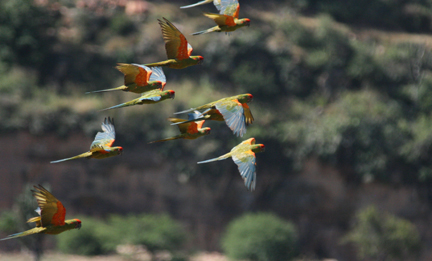New Protected Areas in Bolivia Offer Refuge for Rare Red-fronted Macaw
 Tuesday, February 2, 2010 at 4:51
Tuesday, February 2, 2010 at 4:51  Red-fronted Macaws. Photo: Hugo ArnalWith significant help from ABC, two new protected areas in Bolivia are providing habitat protection for the endangered Red-fronted Macaw and other rare and declining species. The first of these two areas was established in the Andean municipality of Aiquile, while the second, in the neighboring Omereque municipality, will be officially declared later this year.
Red-fronted Macaws. Photo: Hugo ArnalWith significant help from ABC, two new protected areas in Bolivia are providing habitat protection for the endangered Red-fronted Macaw and other rare and declining species. The first of these two areas was established in the Andean municipality of Aiquile, while the second, in the neighboring Omereque municipality, will be officially declared later this year.
ABC helped community residents work collaboratively to designate areas of restricted agricultural development, timber extraction and hunting, which were then mapped and documented in formal management plans by ABC’s partner, the Center for Biodiversity and Genetics (CBG) at the University of San Simon in Cochabamba. ABC provided technical expertise to ensure that the project came to fruition with the best possible benefit for birds.
Together, the two areas cover some 500,000 acres of primarily dry scrub forest that lies in the expansive area between the snow-capped Andean mountains and lowland moist forests. Although this habitat type is found nowhere else in the world, these dry valleys are poorly represented in Bolivia’s protected areas system, perhaps because they have been so sparsely studied in the past. As a result, land is being rapidly cleared for agriculture and cattle and goat grazing, making these two new protected areas particularly important for the macaw and a number of other endemic and threatened species, including the Cliff Parakeet, Bolivian Blackbird, and Andean Condor.
With continued technical and conservation assistance from ABC and CBG, communities can hope to protect critical feeding and nesting sites for the Red-fronted Macaw while developing alternative economic activities such as beekeeping and sustainable forestry. As an immediate next step for 2010, ranger stations and trails will be installed and conservation programs will continue in the 39 communities located within the municipal protected areas.
 Ara rubrogenys - Red-fronted macaw | in
Ara rubrogenys - Red-fronted macaw | in  Conservation,
Conservation,  Reserve
Reserve 
